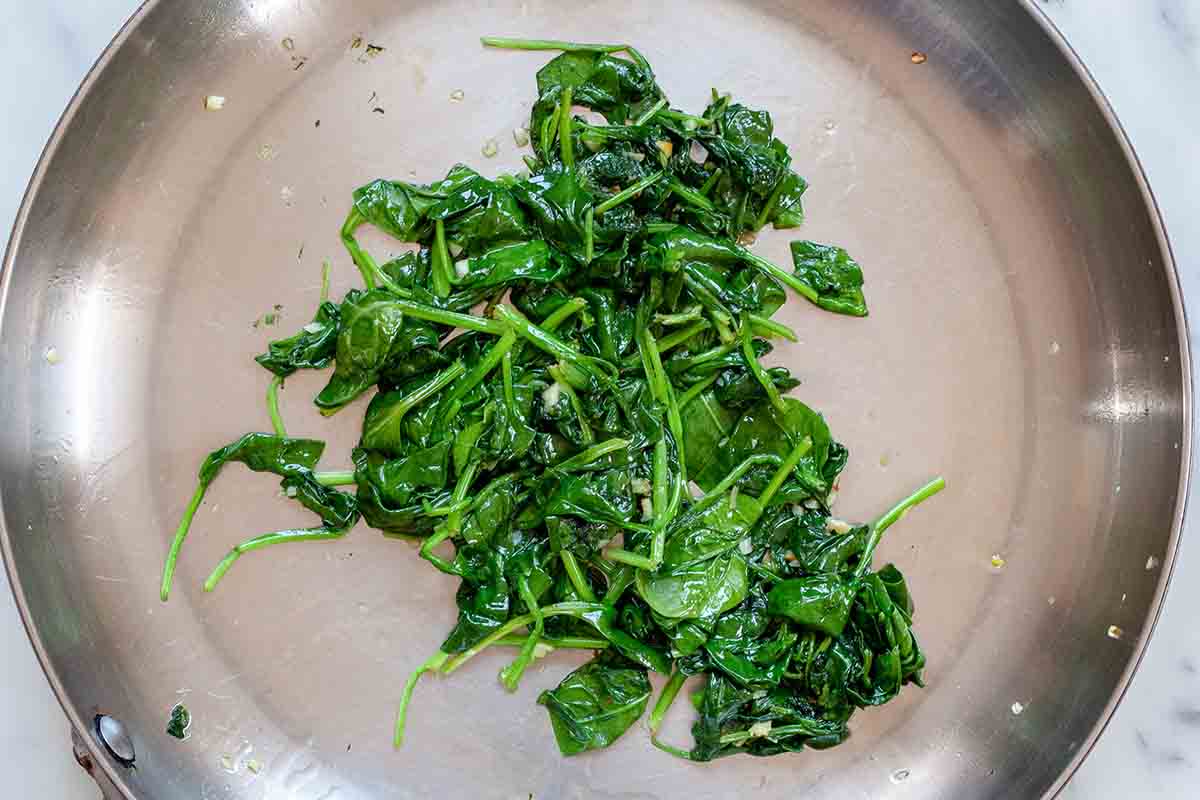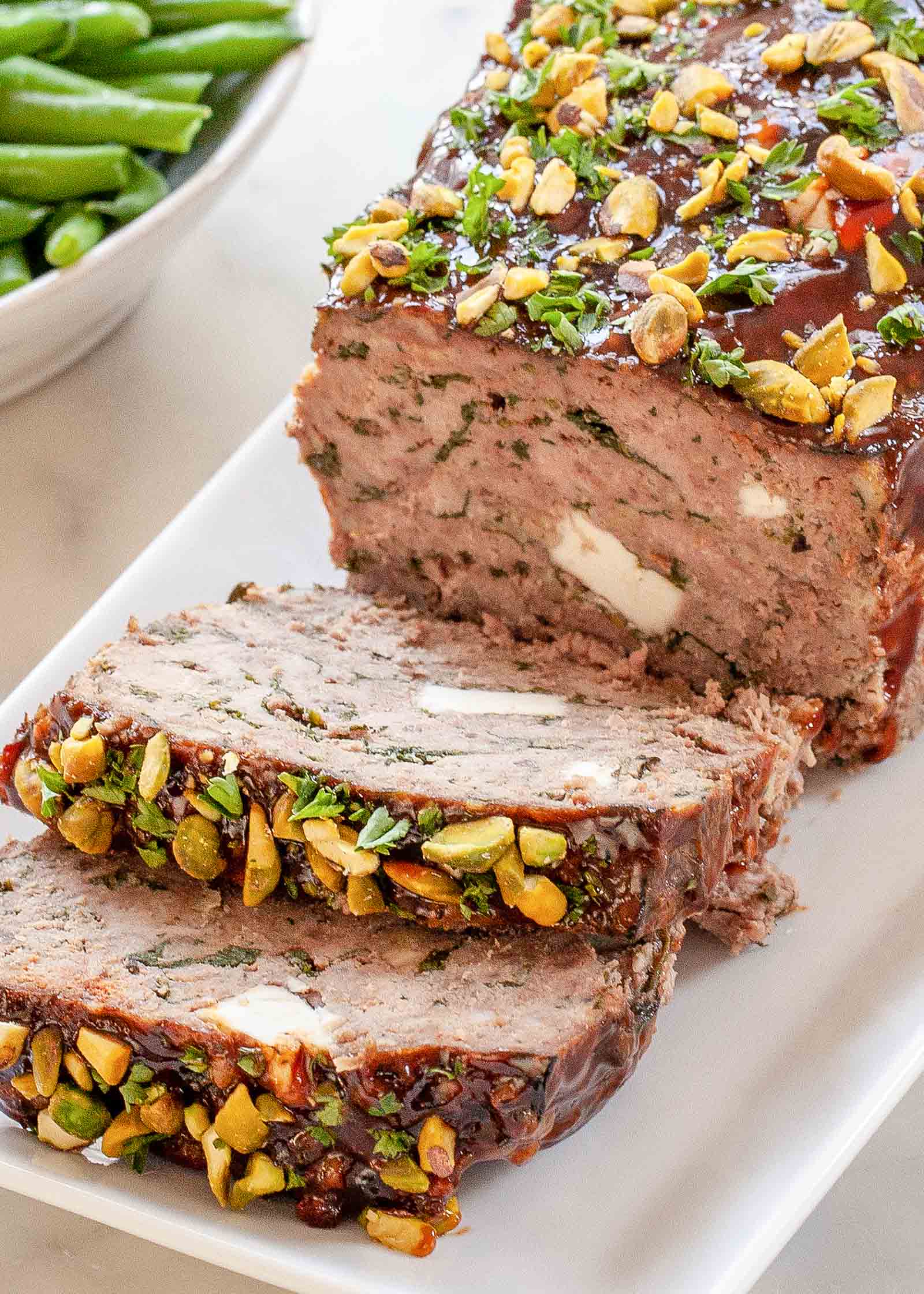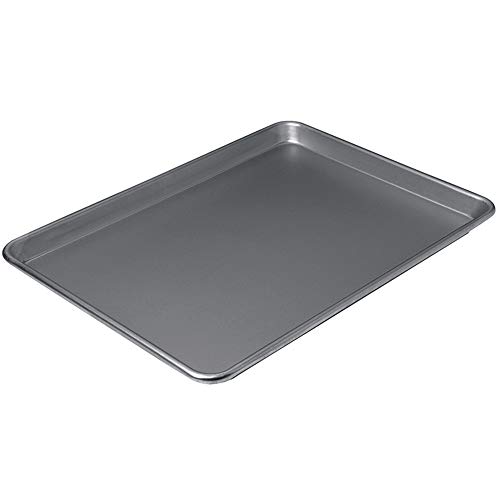Tangy, garlicky, and savory—this Greek meatloaf gets flavor boosts from spinach, feta and pomegranate molasses, a common ingredient in Mediterranean food.
I love my mom’s meatloaf, made with breadcrumbs, egg, and the token veggies of carrots and onions. And of course ketchup on top.
But every once in a while I need a change. This Greek version is made with sautéed fresh spinach, zesty feta cheese, and ground beef. It doesn’t stray too far from classic meatloaf, but the spinach and feta, plus a touch of both ground coriander and cinnamon, make a world of difference.
Keeping with the Mediterranean theme, I topped the loaf with a pomegranate molasses glaze and brightened it with some chopped parsley and pistachios to transform a tasty but—let’s be honest here—drab-looking loaf into something enticing.

GARLICKY GREENS ADD FLAVOR!
When you make the garlicky spinach, start by combining the garlic with the oil in a cold pan (instead of heating the oil first). Set the pan with over the heat, and when it starts to sizzle, stir it for about 30 seconds so it infuses the oil but doesn’t brown or burn when you add other ingredients to the pan. (I use this method when I make tomato sauce, too.)
Next, add the spinach and stir it until it wilts and is just barely cooked—this maintains its freshness.
A NOTE ABOUT THE FETA
For this recipe, avoid the packages of pre-crumbled feta. Buy the cheese in a block and cut it into chunks yourself so they stay in small pieces. Gently mix them into the meat after all of the other ingredients are combined so the cubes don’t crumble too much.
You’ll love taking a bite and finding little nuggets of cheese.
WHAT IS POMEGRANATE MOLASSES?
Thick pomegranate molasses is common in Middle Eastern cooking. Its sweet and sour flavors—quite sour—really perk up meats or chicken, and add pizzazz to stews and even drinks.
It’s made from, you guessed it, pomegranate juice that is cooked down to a thickness similar to cane sugar molasses and it is often a deep reddish-brown color. If you feel like making it yourself, try Elise’s recipe!
You can also buy this ingredient fairly easily at most large supermarkets, some mom-and-pop style Middle Eastern/Mediterranean grocers, and most certainly online.
But if you don’t have pomegranate molasses and want to wing it for this recipe, you make a quick substitute for the topping using 1/4 cup ketchup, 4 teaspoons lemon juice, and 2 teaspoons of sugar for the glaze.

REST THE MEATLOAF BEFORE SLICING
If I had my druthers, I would probably only eat meatloaf the day after cooking it as opposed to the day it’s made. The slices are much more appealing when the loaf has been chilled and firmly set.
But who can wait that long?!
Give the baked meatloaf a rest for at least 15 minutes to let it settle before slicing with a thin, sharp knife. The loaf has a coarse texture that will be somewhat crumbly unless you slice it after it cools, in which case it will firm up and become easier to slice.
WHAT TO SERVE WITH MEATLOAF
A green veggie and mashed potatoes are the classic accompaniment for meatloaf, and they work well with this recipe too. Try these recipes!
HOW TO STORE AND FREEZE MEATLOAF
Don’t forget to squirrel away the leftovers for meatloaf sandwiches! Meatloaf, well-wrapped in plastic, will keep for 3 to 4 days in the refrigerator.
If you want to freeze it, set the remainder of the cooled loaf (or if you prefer, a whole, cooked, cooled unglazed loaf) on a large sheet of plastic wrap. Wrap it whole or cut it into thick slices and wedge small pieces of parchment paper between the slices. Pull the sides of the wrap over the loaf to enclose it well, and wrap it again in foil.
Store in the freezer for up to 3 months. Defrost in the refrigerator overnight and bake in a 350ºF oven until hot all the way through, about 20 to 25 minutes.
LOOKING FOR MORE GREAT MEATLOAF RECIPES?
Products We Love
This post may contain links to Amazon or other partners; your purchases via these links can benefit Simply Recipes. Read more about our affiliate linking policy.




